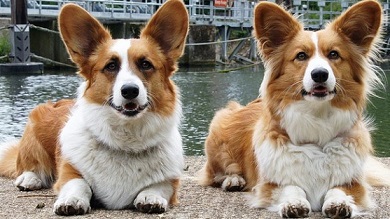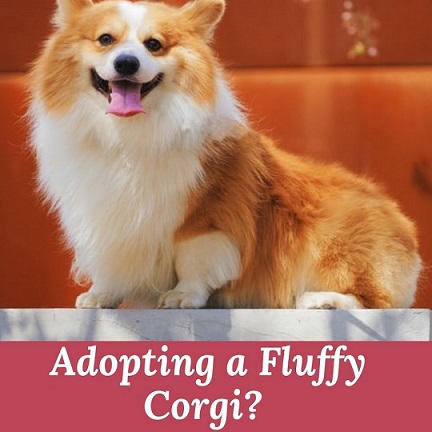Even though a Fluffy Corgi is not commonly seen, it takes one sighting to make you want one.
A Fluffy Corgi has longer hairs on various areas of the body compared to regular Standard Corgi. They are not a variant of Corgi, but a random mutation of this breed.
Read on to find out about the Fluffy Corgi, his coat, and how do they differ from a Standard Corgi.
What is a Fluffy Corgi?
People can’t seem to get enough of this thick coated dog that is cuddly and soft.
A ‘Fluffy Corgi’ is not a rare or special Corgi, they are simply a long-haired Corgi. So what’s all the hype surrounding them?
Fluffy Corgis are a Pembroke or Welsh Corgi that has received the “Fluff Gene” from both parents.
This gene results in double recessive gene mutation that causes hair to grow more thickly around the neck, ears, chest, behind forelegs, and hindquarters.
The fluffy Corgi usually appears to have much longer hair than the regular standard Corgi coat. Any dog lover would love cuddling up to this dog, especially during winter!
How To Know If Your Corgi Is Fluffy or Standard?
For a trained expert it is quite easy to spot out and identify a fluffy Corgi from a Standard Corgi. But for novice or new dog owners, this could be a deceiving task. Allow us to help you make the distinction clearer.
At the age of 8 to 10 weeks, his physical coat characteristics would be visible enough to be recognized as Standard (short-haired) or Fluffy (long-haired) .
Fluffy Corgis have dense long hair on various parts of the body like the chest, ears, behind the hindquarters, and forequarters.
These features might not be visible in the early puppy stages before 8 weeks but will develop later on.
Some Corgi owners may need more concrete evidence to know if their Corgi is fluffy or standard. If this is the case, you can get a DNA kit to detect the presence of a ‘double fluff-gene’.

Why Fluffy Corgis are not Purposely Bred by Breeders?
Fluffy Corgis are more attractive and popular among dog lovers, so why aren’t fluffy Corgi purposely bred by breeders? The answer is quite simple and enforced by Corgi breeders and enthusiasts around the world.
Corgi with the “fluff gene” have long hair, a trait denoted by the AKC as a ‘Fault’. Simply put, a fluffy Corgi is not accepted into dog shows and not desired as a working dog.
Note: There are no health defects associated with this genetic mutation. A fluffy Corgi can live as long as a standard Corgi dog. They feature the same outgoing, playful, and bold characteristics.
Fluffy Corgi vs Regular Corgi: 5 Differences
Looking at these two dogs side by side gives some obvious clues as to what the differences are.
The main difference between a Fluffy Corgi and Regular Corgi is the ‘fluff’; the hair.
A Fluffy Corgi features more hair and longer hair than the regular variant who has short hair and less dense hair. This means that they appear ‘bulkier’ than a regular Corgi.
Of course, a thicker coat does come with some effects!
1) Difficulty in moving
Having extra fur means also having extra weight. The fluffy Corgi could show less movement or difficulty in moving. Something that the regular Corgi has no issues. This could lower your Corgi’s activity levels.
2) More shedding and grooming
If you hate spending too much time grooming your pet, the Fluffy Corgi is not for you!
Longer hair that tends to be denser is likely to take a chunk of your time. Even if you do not have time, you will need money to send him to a professional groomer!
Read here to know the available Welsh Corgi Coat Colors.
3) Breed Standards
The Corgi breed standards clearly mention that a ‘fluffy’ coat is a major defect.
Only the regular Corgi coat is accepted as the standard. That means that your fluffy Corgi will not be accepted in dog show competitions.
4) Not useful in a working dog
Working Corgis are prone to getting dirty but shorter coats are not prone to getting too messy.
A fluffy Corgi is more likely to get mud, mats, and tangles in its coat. This then takes a lot of time in his grooming.
5) Prone to Heatstroke
The excess hair on the fluffy Corgi makes him feel hotter.
He will have a difficult time regulating his temperature! When he feels overheated, he will get tired sooner and be less productive.
Can You Make Your Corgi Fluffier without the fluff gene?
So now that we have established that people prefer the fluffy Corgi, a reasonable question follows. Can I make my Corgi fluffier?
It might sound crazy but it is true that many people ask this question. If a Corgi does not have the ‘fluff gene’, it is difficult to artificially create the fluffy look.
Here are some steps to try to attempt recreating the fluffy look without genetic support. These steps are not guaranteed to bring about the desired results but might help and is worth a try.
1. Brush your Corgi on time with the right tools
Adopting a grooming routine for your Corgi could help to promote and stimulate good quality hair. Preferably, Corgis should be brushed 2 to 4 times a week.
- Brushing sessions should last around 20 minutes, divided into two parts
- Use a rake brush for the first half of the brushing session (for the thick undercoat)
- Switch to a slicker brush for the second half of the brushing session (for the top coat)
Both brushing tools are effective against shedding and hair damage due to incorrect brushing tools. Hopefully, this can make your Corgi look a bit fluffier.
2. Spare them from over-bathing
Bathing is aimed at keeping a dog clean from dirt and excessive body oils.
But bathing your Corgi too often with bad shampoos will be negative on the skin.
Stick to a bath once every month or two using natural shampoos. Oatmeal-based shampoos that lack alcohol, parabens, and other chemicals are our advice for Corgi owners.
Adapting to this bathing regime can help restore natural levels of oils in the skin of your Corgi. These oils stimulate growth of thick hair, making your Corgi appear healthier and fluffier.
3. Food says it all!
What’s on the inside shows on the outside! We are talking about diet of course.
Diet provides all the nutrients for growing a thick, full, shiny, and fluffy coat. Poor quality food equates to poor hair growth on the coat leading to a thin dull coat.
Plus many protein ingredients (chicken beef, pork, lamb) may contain allergens that lead to poor digestion. When a Corgi is unable to digest protein, his coat will suffer the consequences. To avoid diet-based indigestion, you may switch to salmon-based kibble.
Salmon and other fish-based kibble are much easier to digest. Additionally, they contain vital minerals and nutrients such as Omega 3 and Omega 6 (fatty acids). Both these fatty acids are essential for optimum growth and health of skin and hair.
4. A few supplements won’t hurt
If your Corgi has a thin coat even with a well-balanced diet, something is still missing. Supplements are likely to solve the problem and promote internal and external health.
Fish oil or flaxseed oil are the best dog supplements for hair growth.
NOTE: Speak with your vet before trying this. If you get permission, test it on your dog first to see if he likes it. Dog-friendly supplements usually exist in the market and you need to carefully select the right one.
Supplements provide crucial health components in a concentrated amount. Perhaps this is all your Corgi needs to have a spurt in hair growth. These supplements strengthen the skin and hair simultaneously to create all-around growth.
How and where to find Fluffy Corgi?
The Fluffy Corgi is not that easy to find. They are not purposely bred, it is actually by chance that they are born. A litter may randomly have Fluffy coat puppies along with regular coat ones.
In fact, Corgi breeders have a rule that Fluffy Corgis must be neutered! This is to ensure this Corgi is not intentionally bred.
Maybe a Corgi mix will better suit you. Get to know about the Corgi Shiba Inu Mix.
Pembroke Corgi vs Cardigan Corgi
You would also need to decide on before you adopt a fluffy Corgi is which variant you want.
- Pembroke Corgis are marginally larger than their counterparts. They also have a long tail.
- Cardigan Corgis are smaller, with a rectangular body, and usually have a docked tail.
Either one will make an exceptional companion. Depending on demand and availability on the market, you can adopt one.
Before You Adopt a Fluffy Corgi!
As you have come to know, a fluffy coat is not a desired trait in working Corgis.
A working fluffy Corgi will not be able to keep its coat untangled and mat-free. The coat may affect the activity levels or mobility of the dog.
This is why Fluffy Corgis usually come with a neutering contract. These attempts are made to ensure this genetic mutation does not carry through to future Corgi puppies.
Need to know if the Corgi is safe for allergies, we will answer the question- Are Corgis Hypoallergenic?
Conclusion
Choosing between a regular Corgi and a fluffy Corgi comes down to personal preference.
Yes, a fluffy one is cute and cuddly and makes a great family companion. However, they are not the best working dog to help you round up your livestock.
FAQ
Are Fluffy Corgi more expensive?
Yes, Fluffy Corgi dogs are more expensive. You should expect to pay an average of $2500 for one.
It also depends on the breeder you choose. Some breeders say this dog is “rare” or a “specialty”, which is greatly misleading. It falsely gives them a reason to overcharge.
A regular Corgi costs $600 to $1200, but higher quality puppies derived from a show line parent can surge past $4000!
Do fluffy Corgi like to cuddle?
Yes, a fluffy Corgi will definitely like to cuddle his owners. These dogs are highly social and instilled with a protective instinct.
Sticking close to his family is the best way to also protect them. Hence, your lap will be his favorite spot in the house. He will stay put for hours if you allow him to!
Can I find a Fluffy Corgi breeder?
You are not likely to find a fluffy Corgi breeder. They are randomly created while breeding by quality breeders. Any breeder who claims to specialize in the ‘fluffy Corgi’ is probably a low-quality breeder that is not taking safety precautions.
This can result in a depleted gene pool and you should avoid them.
Are Corgis supposed to be fluffy?
No, Corgis are not supposed to be fluffy. It is purely caused due to an unintended genetic mutation. A Corgi is fluffy when he gets two recessive fluff genes, one from each parent.
According to the AKC, a Corgi having the ‘fluffy gene’ is considered a fault. Breed standards clearly state that Corgi are most desirable with a short coat which is quite coarse.
But if you are getting a fluffy for the sole purpose of companionship, there is no reason why he shouldn’t be fluffy.
Can a fluffy Corgi be left alone?
No, leaving your fluffy Corgi (or any Corgi) alone is not a wise decision. This is simply because Corgis are prone to developing separation anxiety.
If you need to be away for long periods of time, try to get a dog-sitter or relative to look after your dog.

